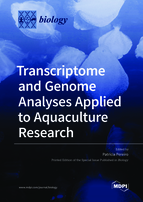Transcriptome and Genome Analyses Applied to Aquaculture Research
A special issue of Biology (ISSN 2079-7737). This special issue belongs to the section "Genetics and Genomics".
Deadline for manuscript submissions: closed (30 April 2022) | Viewed by 73432
Special Issue Editor
Interests: immunology; diseases; vaccines; genomic; transcriptomic; aquaculture
Special Issues, Collections and Topics in MDPI journals
Special Issue Information
Dear Colleagues,
Overfishing is an important concern, mainly due to the on-going increase in the size of the human population. Fortunately, aquaculture has emerged as an alternative supply of fish and shellfish. In recent years, although capture fishery production has been flat at approximately 90 million tonnes per year, aquaculture has continued to show sustained growth, amounting to 80 million tonnes in recent years. Therefore, fish and shellfish aquaculture represent a powerful economic sector all around the world.
The lowering cost of the next-generation sequencing (NGS) strategies in recent years has allowed the genome sequencing of numerous fish and shellfish species with relevance in the aquaculture industry. This represents an important tool for geneticists, since the availability of whole genomes facilitates the search for genetic markers or genes associated with different traits of interest. Massive transcriptome analyses have also become indispensable to study different questions of interest (nutrition, growth, disease resistance, reproduction, etc.) but, in addition to the study of the mRNA expression, the role of the non-coding RNAs (especially miRNAs and lncRNAs) in these aspects has received reached great interest in the last few years. Moreover, the study of the epigenome and the implications of epigenetic modification under certain conditions is being rapidly expanded to aquaculture research.
This Special Issue welcomes papers on the genomics, epigenomics, and transcriptomics of fish and shellfish species of interest in aquaculture. Manuscripts focusing on high-throughput methodologies will be appreciated.
Dr. Patricia Pereiro
Guest Editor
Manuscript Submission Information
Manuscripts should be submitted online at www.mdpi.com by registering and logging in to this website. Once you are registered, click here to go to the submission form. Manuscripts can be submitted until the deadline. All submissions that pass pre-check are peer-reviewed. Accepted papers will be published continuously in the journal (as soon as accepted) and will be listed together on the special issue website. Research articles, review articles as well as short communications are invited. For planned papers, a title and short abstract (about 100 words) can be sent to the Editorial Office for announcement on this website.
Submitted manuscripts should not have been published previously, nor be under consideration for publication elsewhere (except conference proceedings papers). All manuscripts are thoroughly refereed through a single-blind peer-review process. A guide for authors and other relevant information for submission of manuscripts is available on the Instructions for Authors page. Biology is an international peer-reviewed open access monthly journal published by MDPI.
Please visit the Instructions for Authors page before submitting a manuscript. The Article Processing Charge (APC) for publication in this open access journal is 2700 CHF (Swiss Francs). Submitted papers should be well formatted and use good English. Authors may use MDPI's English editing service prior to publication or during author revisions.
Keywords
- transcriptomics
- non-coding RNAs
- genomics
- epigenomics
- aquaculture
- fish
- shellfish
- RNA-Seq
- microarray
- ChIP-seq







